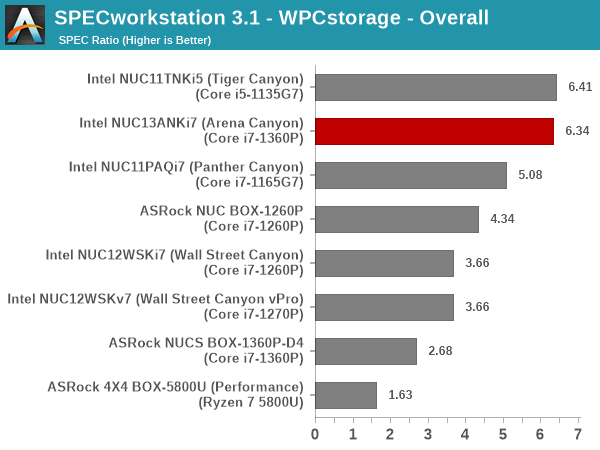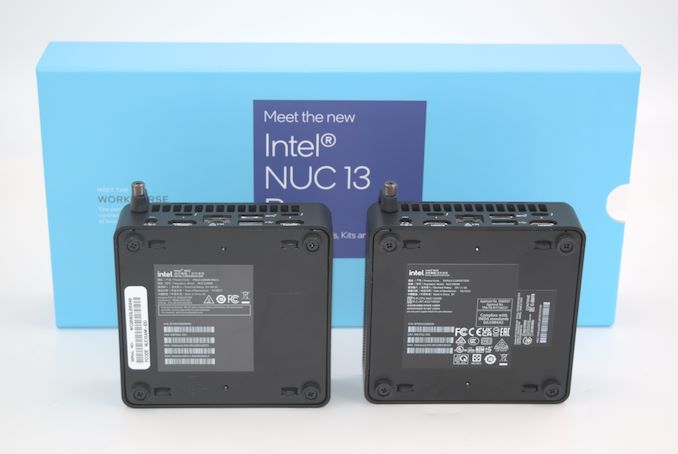Intel NUC 13 Pro Arena Canyon Review: Raptor Lake Brings Incremental Gains
by Ganesh T S on March 27, 2023 9:00 AM ESTMiscellaneous Aspects and Concluding Remarks
Networking and storage are aspects that may be of vital importance in specific PC use-cases. The Intel NUC13ANKi7 (Arena Canyon) comes with the Wi-Fi 6E AX211 WLAN card that also includes Bluetooth 5.3 support. On the wired front, the Intel I226-V controller backs up the 2.5 Gbps RJ-45 port. Dual LAN options are available in select Arena Canyon NUCs, but not in the specific SKU that we looked at today.
On the storage side, we have seen that UCFF PCs typically struggle with PCIe 4.0 x4 NVMe SSDs due to the lack of an effective thermal solution. We saw in the previous section that the temperature profile of the Samsung PM9A1 SSD is quite reasonable under stress. From a benchmarking perspective, we expect the SSD to deliver good scores without throttling in the WPCstorage test of SPECworkstation 3.1. This benchmark replays access traces from various programs used in different verticals and compares the score against the one obtained with a 2017 SanDisk 512GB SATA SSD in the SPECworkstation 3.1 reference system.
| SPECworkstation 3.1.0 - WPCstorage SPEC Ratio Scores | |||

The graphs above present results for different verticals, as grouped by SPECworkstation 3.1. The storage workload consists of 60 subtests. Access traces from CFD solvers and programs such as Catia, Creo, and Solidworks come under 'Product Development'. Storage access traces from the NAMD and LAMMPS molecular dynamics simulator are under the 'Life Sciences' category. 'General Operations' includes access traces from 7-Zip and Mozilla programs. The 'Energy' category replays traces from the energy-02 SPECviewperf workload. The 'Media and Entertainment' vertical includes Handbrake, Maya, and 3dsmax. Given that the comparison is between a wide range of SSDs in the systems - including both Gen 3 and Gen 4 NVMe, the relative numbers for most workloads are not surprising. As expected, the top two spots are taken up by the Gen 4 x4 high-end Samsung PM9A1 in the Arena Canyon NUC and its direct-to-consumer equivalent (980 PRO) in the Tiger Canyon NUC. Both deliver similar numbers within permissible run-to-run variations.
Closing Thoughts
The NUC 13 Pro Arena Canyon lineup is one of Intel's most comprehensive offerings in the UCFF space for business use-cases. A decade of experience listening to customers and analyzing deployments has allowed the company to produce a system with just the right mix of hardware and software features for different domains. The NPSS software feature for digital signage applications addresses some of the pain points inherent in existing solutions. Addition of a powerful processor in the background enables these displays to bring intelligence into the mix and scale well beyond being dumb terminals.
Despite not being the first to market with a Raptor Lake-P UCFF PC, Intel has managed to make the Arena Canyon NUC stand out. The system BIOS has been optimized to increase power efficiency without sacrificing performance. The sheer number of SKUs ensure that there is a system fulfilling the targeted use-cases for every desired price point.
Intel's Raptor Lake-P is quite close to Alder Lake-P architecturally. The core counts, cache sizes, and heterogeneous combinations are pretty much equivalent. Under such circumstances, it is indeed surprising that just process advancements have enabled Raptor Lake-P to provide satisfactory improvements in performance as well as power efficiency over Alder Lake-P.

NUC 13 Pro Arena Canyon NUC (L), NUC 12 Pro Wall Street Canyon NUC (R) - Hard to Differentiate
Positives aside, it is puzzling to see Intel not taking the lead in bringing DDR5 SODIMM support into the UCFF space. The similarity of the I/Os and board features to the Wall Street Canyon NUCs is also a bit of a concern. While we do not have concrete pricing information yet, online retailer listings seem to place it in the same ballpark as that of the Wall Street Canyon NUCs. Under such conditions, it is difficult to see why anyone would prefer the NUC 12 Pro units over the NUC 13 Pro - particularly when the former is slated to be in the market for the foreseeable future. Intel could have put in some more differentiation between the two - say, allowing in-band ECC to be enabled, or more Thunderbolt 4 ports, or adding a SD card slot, or even just changing the retimers to enable USB 3.2 Gen 2x2 20 Gbps support. Those could have justified a premium and allowed the Wall Street Canyon NUCs and Arena Canyon NUCs to coexist in the market.
The wide range of SKUs, longer life-cycles, and better performance as well as energy efficiency over the previous generation are bright spots for the Arena Canyon NUC lineup. The NUC 13 Pro family comfortably delivers upon its promise, but there exists a nagging suspicion that Intel has deliberately set the bar low this time around.










46 Comments
View All Comments
PeachNCream - Tuesday, March 28, 2023 - link
I congratulate you. Your bait caught a lot of them this time. And, like a true troll, you didn't waste keystrokes doing it. Though, admittedly, computer enthusiasts are low hanging fruit that get riled up with minimal work.MrCommunistGen - Monday, March 27, 2023 - link
I'm pretty pleased that there are P-series chips and not just U-series - as many (but not all) previous SFF NUCs used 15W TDP chips rather than 28W and higher TDP mobile CPUs. As long as the cooler can handle the heat load and isn't too terribly loud (or can have its performance/fan curves adjusted) then this could be a really cool SFF PC.I currently have a NUC8i7BEH i7-8559U (28W 4c/8t + eDRAM) which I'm not YET looking to upgrade, but this new 13th Gen NUC is the first model that's gotten me excited about a new NUC in this form factor.
Samus - Tuesday, March 28, 2023 - link
I agree. The P-series was a solid move on Intel's part to stay competitive against Ryzen mobile parts. Even though most notebooks don't seem to utilize the TDP Up (if its a thin plastic laptop kiss PL2 goodbye entirely) the single-threaded boost performance is above U-series parts, and general workflow at low-loads benefit from the stronger E-core headroom. Intel competitively prices the P chips against the U chips as well, which is why you see them in cheaper laptops.abufrejoval - Tuesday, March 28, 2023 - link
The latest U-series to me represent an attempt to have at least a toenail in a fully passive market and that's not an economy niche, even if Intel can put more of them on a wafer: sometimes Intel is strangely insensitive to wasting die area!And since NUCs have always used active cooling even for their Atom models, U-series SoCs simply have no business there.
I am also a fan of the great NUC fan curves, because they allow you to achieve unobtrusiveness, which is only beaten by "never need cleaning out fans and grills", but not at the price of crippled performance or an Akasa case.
I have the same NUC and it's younger cousins, a hexacore NUC10 and a Tiger Lake NUC11. And that last "custom Apple" SoC with the Iris 655 iGPU in the i7-8559U spends more than half its die area on an iGPU that Intel never charged for, but mostly because it didn't actually pay of in performance.
The Tiger Lake trounces NUC8 and 10 by 25% on scalar peformance while the 6 cores of Gen10 and 4 cores of Gen11 draw even on multicore.
The Tiger Lake's 96EU Xe iGPU puts the Iris 48EU iGPU to shame, which only gets 50% performance increase over an 24EU iGPU from the NUC10 for twice the EUs and without needing the eDRAM, which doesn't help nearly as much as it must have cost in production. It marks the turning point for Apple, which wanted much more GPU power at mobile power budgets.
Yes, you can expect a tempting performance uplift from one of these, should you make the switch. But a gaming engine it won't be, because 4x the speed of a lame duck is still pretty lame.
ekon - Monday, March 27, 2023 - link
I like the multitasking benchmarks; don't see that attempted very often as it's not an off-the-shelf test and involves the time and risk of coming up with your own methodology, but it's teased out some interesting results.cruiseliu - Monday, March 27, 2023 - link
Kinda surprised it's still DDR4.Samus - Tuesday, March 28, 2023 - link
I was surprised to see that too. Even 6 months ago I wouldn't be since DDR5 SODIMMs were still elusive unicorns but nowadays they are plentiful and price competitive with DDR4. I've seen 32GB 16x2 kits of Crucial DDR5 5200(?) SODIMMs from B&H for $100 shipped yet nothing mobile seems to take DDR5, and if it does, it's non-upgradable (looking at you XPS 13)Fenturi - Tuesday, March 28, 2023 - link
U690 6800hx based with swappable ddr5MrCommunistGen - Tuesday, March 28, 2023 - link
Me too. I was going to write a follow-up comment about that, but then got a bit derailed writing my anti-rant comment.I suspect that the re-use of DDR4 was a cost saving measure so that they could (mostly) re-use the memory traces, etc from previous NUC boards instead of having to rework that for DDR5.
DDR5 doesn't help all workloads, particularly at JEDEC speeds, but there's definitely some where it helps. Having that little bit of extra performance in this form factor would be appreciated.
Einy0 - Tuesday, March 28, 2023 - link
In response to all the Mac mini comments. I've wanted to dip my toe into the OSX pond for a while now. I do some moonlighting for a business that uses a lot of Macs, and I feel like more hands on time with a Mac would be useful. The ancient Macbook own gives me some exposure but a lot was changed since OSX 10.6.8 . I just can't bring myself to get a mini with only 8GB or RAM. My Macbook has 4GB and a decent SSD and it is SLOW! I imagine newer versions of OSX are more memory hungry, like everything else. I also WILL NOT pay $200 more for $25 worth of RAM. It is plain insulting! Shame on Apple...